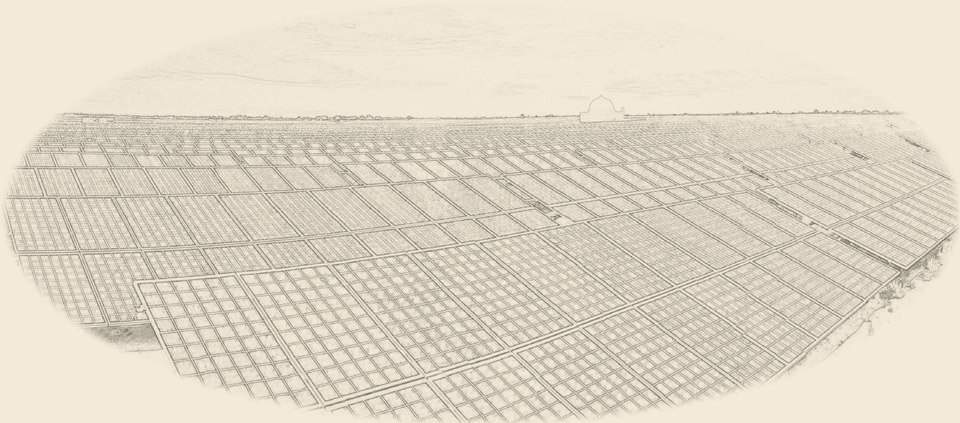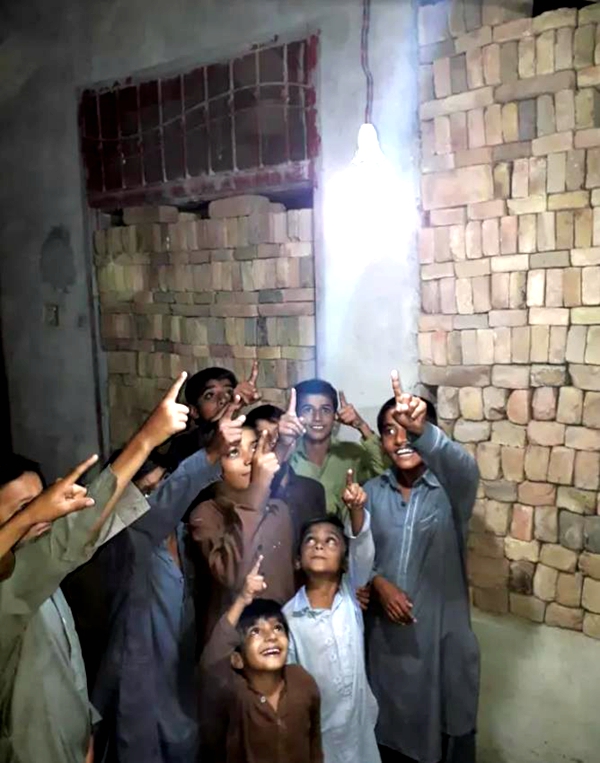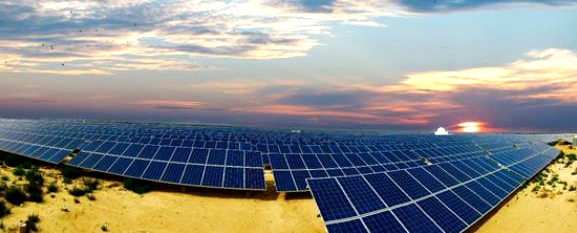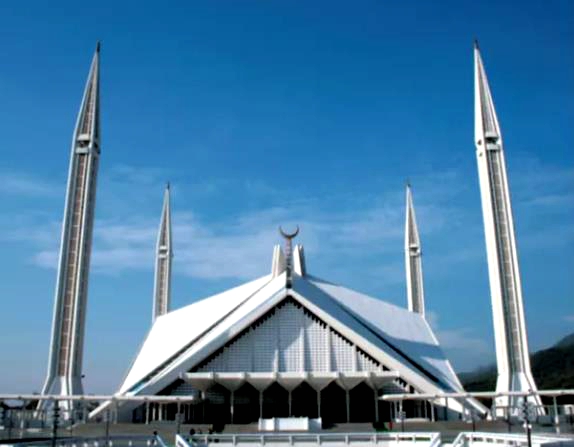Lighting Up the Land of Punjab
by Zhang Yuwen
[Pakistan] Hafaiz Awais
When Isaac's Chinese colleague Yang Shuai showed him a photograph of the Cholistan Desert on his mobile phone, the sight of the carpet of green grass growing in the barren desert left the Pakistani engineer incredulous.

Isaac, whose family has been living in the desert region for generations, refused to believe it at first. "Impossible," he said. "The desert has nothing but sand. So how can grass grow there? And so much over such a large area!"
The Cholistan Desert, lying on the outskirts of the city of Bahawalpur in the Punjab Province of Pakistan, showed little sign of human habitation since ancient times. It lay desolate under a scorching sun shining directly overhead, looking like an uninhabited alien planet.
It is incredible to see green grass growing there. But what is even more amazing is that the desert has become the source of power for Isaac and his community. A 900-megawatt (MW) solar power plant, the Zonergy Pakistan photovoltaic (PV) power plant, is being built there and once completed, is expected to generate about 1.3 billion kilowatt-hours (kwh) of clean electricity annually. This will alleviate the problem of local power shortage, improve people's livelihood and boost the local economy.
Life Without Blackouts
Punjab is the most agriculturally and industrially developed province in Pakistan, with a population of more than 100 million. However, it remained plagued by severe power shortage for a long time, suffering routine outages. Things were much worse in the remote rural areas where people got three or four hours of electricity daily at the most, which seriously affected their lives and crippled economic growth.

"Power on"
"We lived without power for up to 12 hours a day in summer, which hit our lives hard," 28-year-old Salem, a resident of Punjab, said. "We would wake up in the middle of the night due to the heat, sweating all over. We had bought electrical appliances that cost us a lot of money but they became mere showpieces that could not be used. Candles became a daily household necessity. The regular power outages made me feel utterly frustrated." When Salem heard Zonergy was recruiting people for a power project in the province, he applied with alacrity.
Not just in Salem's city, power shortage was a widespread problem in the region. The region lacked coal resources and it was expensive to buy fuel from other places. So the authorities wracked their brains to come up with a solution to the power shortage.
The answer was solar power generation.
Considering Pakistan's natural climatic conditions, Chinese energy conglomerate Zonergy Co. Ltd. suggested building a PV plant.
Builders then turned their attention to the Cholistan Desert.
Although unfit for human habitation, it was an ideal spot for a PV power plant. The desert gets 3,000 hours of sunlight annually, making it one of the areas in the world with the highest solar radiation. So solar power was the ideal choice. Though thermal power stations can generate more power, PV plants can be completed faster and swing into operation to meet the demand at top speed.
The first phase of Zonergy's PV power plant was connected to the power grid more than three years ago, providing 300 MW. By June 2019, it had generated 1.56 billion kwh of electricity, meeting the power needs of about 280,000 local families. The blackouts have been reduced to one or two hours a day, easing the local power shortage. Moreover, in contrast with traditional thermal plants, PV plants are more environment-friendly. They can reduce the use of coal by about 170,000 tonnes and cut down greenhouse gas emissions by 400,000 tonnes.
To promote the sustainable development of local resources and protect the environment, the government of Pakistan plans to gradually increase the proportion of green energy in the total power generated in the future. Zonergy's PV plant has become a pioneer in developing solar power in Pakistan, setting an example for the country's future progress in green energy generation.
Salem has become a team leader at Zonergy. Every day, as he inspects the plant, the sight of the rows of PV panels gives him a sense of satisfaction and accomplishment. "I think my work is very meaningful," he said. "When the 900 MW plant is fully completed, the blackouts will be gone. We are moving closer to that day," he said.
Hot Weather Challenges
It isn't easy to build a PV plant in the desert.
Under the blazing sun, the builders suffered terribly.
In June, the temperature reaches 50 degrees Celsius in the desert. It is hard to even stand in the sun, let alone build something. The desert becomes boiling hot like a steamer and there are daily cases of people coming down with heat stroke.
At the early stage of construction, there was no water supply, accessible road or electricity. Everybody had to sleep in the containers, shivering in winter and boiling in summer.
Piling, installing posts to support the foundation, was a major work in the project. If the piling was not done in time, the entire work would be delayed. Drilling is the first step in piling. However, inconceivably, there was only one professional mechanical drilling crew available in Pakistan, which made it seem impossible that the engineering would be completed in time.
What could be done? Since the project had a deadline, everyone was urged to help in any way they could and as a result, "indigenous methods" of drilling emerged one after another.
The construction site witnessed a wide range of drilling methods that seemed to exhibit the complete evolution of drilling technology. Besides those operating the conventional large mechanical drilling machines, there were 20 workers with hand-held small drills, while another 50 did manual digging. There were even people steering "drilling machines" converted from tractors. With various devices and at different speeds and frequencies, they jointly constructed the pile foundations, big and small. The different machines, emitting different sounds, seemed like a "band", giving a high-speed and high-level performance in the summer heat.
It was an even greater spectacle when several hundreds of workers began to spool off the cables. The cables used in the construction were thick, heavy and several km in length. They needed to be unwinded from the spool and put into the cable trench. Since the team was short of equipment, the work had to be done using manpower. Several hundreds of people lined up to do the task by hand. "One! Two! One! Two!" They shouted in chorus to orchestrate the action, their shouts ringing out in the vast desert.
More than 500 Chinese technicians and around 3,000 Pakistani staff participated in the construction of the first phase. Together they withstood the rainy season, the hot summer, sandstorms and technical challenges to build the project with high standards.
While meeting the challenges together, the Chinese and Pakistani colleagues became close, sharing weal and woe.
The Pakistani technicians and workers learned from the job, which improved their skills. Some of them are now in charge of operations. Since the plant was connected to the power grid, the Chinese and Pakistani engineers have been jointly doing the daily operation and maintenance, with Pakistani engineers accounting for 80 percent of the staff.
"We suffered due to the soaring temperature that rose above 50 degrees Celsius, we were bitten by mosquitos from head to feet and we missed our families. But everyone stayed on so that we could complete the project early," Yang Shuai, a young civil engineer said.
Zonergy's 900-MW power plant has not only given electricity to Pakistanis but also illuminated the communication and cooperation between two different civilizations and the integration of the wisdom and culture of the employees from the two countries.
"When sleeping in the containers, in spite of the primitive conditions, I was heartened by the sight of the PV panels all over the area. I am so proud to tell my friends that I have shared in the work to build the plant," Zardran, a Pakistani employee, said during lunch break, affectionately patting his Chinese colleague Wang Yixin.
"If your friends wish, they can apply to work in the second phase. We are going to need a lot of people as the second phase is about to start." Wang Yixin responded with a smile.
Gleaming Mosque in Solar-Powered Oasis
As the sun goes down, the afterglow lingers, turning the sky crimson. The crimson glow bathes a white mosque standing in the desert as an embodiment of peace.
Behind the mosque stands a row of blue PV panels.
While building the plant, the construction team found the mosque stood in the very area where the project was to start. The owner told the team that it could be demolished and the local people too didn't object. However, in consideration of local religious customs, Zonergy modified the project plan to preserve the mosque.
In addition, the company renovated the mosque's walls and roof and repaired its well, making it convenient for the villagers as well as their local staff to pray at the mosque.

The PV power plant and its nearby mosque at the sunset
For employees who are on duty and unable to go to the mosque to pray, there is a prayer room at each booster station of the plant. At the end of every workday, the haunting sound of the azan, the call to prayer, issues out of the radio, a reminder that it's time for the evening prayer. Some employees go to the mosque with nearby residents.
"Respecting local culture" is not an empty slogan here.
When the month of Ramadan, a period of fasting, comes, local workers don't eat in the daytime or even drink water. As it is difficult for them to work in full swing, the Chinese employees do their best to do more.
During the Eid al-Fitr (Festival of Breaking the Fast) and Eid al-Adha (Festival of Sacrifice) holidays, the local staff receive gifts and a festival bonus from the company, join the dinner party organized by the company and enjoy a paid vacation. During this time the Chinese station chiefs substitute for their local colleagues and arrive at work at 5 a.m. to ensure normal operation of the plant.
"I appreciate all my Chinese colleagues. They really respect our culture and customs. To communicate with us better, they have learned Urdu by themselves. Now we play table tennis together," Harima, a Pakistani employee, said. He had just finished attending the evening prayer at the mosque and was heading for home.
Though it is dark, the mosque shines bright.
Cholistan Desert today has a blue sea. It is made up of over a million blue PV panels.

A scenery in Pakistan
"In the past, even the locals wouldn't go to the desert. But now it has turned into the most advanced solar-powered oasis," Isaac said, pointing at the surrounding PV panels. "The plant gave us another bonus. The water used to clean the PV panels drips on the ground and seeps into the soil, causing grass and other plants to grow in the barren desert. This can partly prevent further desertification and stabilize the sand."
The vegetation attracts animals like hares, porcupines, snakes and even wolfs and pangolins, turning the dead desert into a place full of life.
Pakistan used to be an important halt on the ancient Silk Road. Chinese monks Faxian from the Eastern Jin Dynasty (317-420) and Xuanzang of the Tang Dynasty (618-907) visited Taxila, an ancient city in northwestern Pakistan, and brought Gandhara art from there to China.
A thousand years later, China has introduced clean new energy in Pakistan, and the Chinese "solar-powered oasis" project has lighted up people's home and warmed their hearts. Each unit of green electricity generated here comes with the profound friendship of the people of the two countries.
FOR MORE
Project Overview:
The Zonergy Pakistan 900-MW PV power plant project is located at a solar park in Bahawalpur in Punjab Province. Officially launched in May 2015, the project's 300-MW first phase was connected to the power grid in June 2016. During the construction, more than 3,000 local jobs were created. The project trained about 100 engineers and dozens of skilled workers in PV operation and maintenance.
The first phase has been completed, directly supplying electricity to Bahawalpur and meeting 30 percent of the region's power demands. It has effectively eased the local power shortage and contributed to local economic growth. It has also improved people's lives, increased employment, trained PV personnel and optimized the energy structure.


